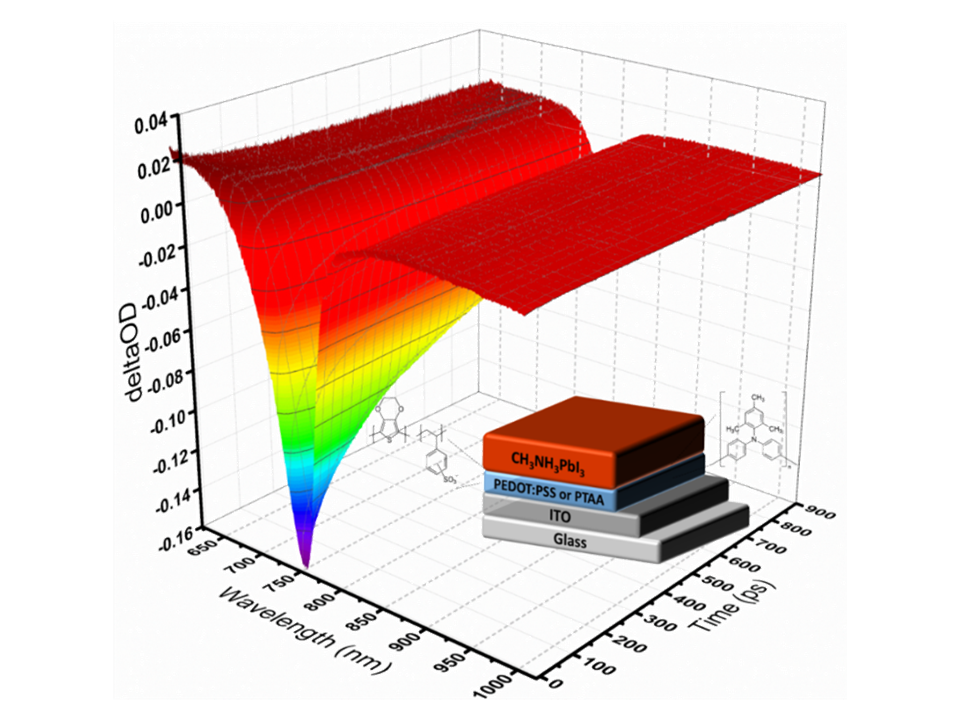Objective: The objective of this activity is the application of ultrafast laser time-resolved spectroscopy in the fields of photovoltaics, thermoelectric polymers, and plasmonic photocatalysts towards optimizing materials performance and expanding their applications.
Abstract: In Photovoltaics: Femtosecond time-resolved Transient Absorption Spectroscopy (TAS) is used for studying the fundamental photo-physics and decay dynamics in organic photovoltaics (OPVs) and perovskite solar cells (PSCs). Namely, TAS provides important insights on the charge carrier dynamics such as electron-hole injection times and exciton recombination rates that are well known to be directly correlated with the performance of the devices. Figure 1a presents a schematic representation of TAS experimental setup, while Figure 1b depicts a typical optical density (ΔOD) spectrum of a glass/ITO/PEDOT:PSS/CH3NH3PbI3 architecture as a function of wavelength and time from which the charge carrier dynamics are revealed upon following fitting analysis. Notably, the TAS setup in ULMNP Laboratory allows the performance of measurements under dry ambient, as well as, in-situ probing at variable temperatures. This part of the research activity is implemented by a joint effort between the ULMNP Group and the Nanomaterials and Organic Electronics Group of the Center of Materials Technology and Photonics (CEMATEP) of the Hellenic Mediterranean University (HMU), headed by Prof. Emmanuel Kymakis. Our continuous mission is to provide research facilities for state-of-the-art research in the multidisciplinary field of nanotechnology and advanced electronics. In brief the activity focuses on the following:
- Exploring the effect of hole transport layer on the charge transfer, carrier trapping and hole injection dynamics within PSCs.
- In-situ monitoring of the charge carrier dynamics of CH3NH3PbI3 perovskite during crystallization process.
- Transient photo-induced bleaching relaxation dynamics in OPVs.
- Correlation of charge carrier transport dynamics with electrical measurements towards enhancing device performance and stability.

Figure 1: (a) Schematic representation of TAS experimental setup. (b) Optical density (ΔOD) transient absorption spectra of a glass/ITO/PEDOT:PSS/CH3NH3PbI3 architecture.
In Thermoelectric Polymers: Along similar lines, the application of TAS technique is expanded to thermoelectric composite polypropylene-based polymers that contain carbon nanotubes (CNTs). The latter are responsible for generating electrical current upon exposure to temperature differentials. Recent data from our Laboratory reveal that TAS is powerful technique and a figure-of-merit method to explore ultrafast phenomena and relaxation processes that take place within these CNT composite polymers, and thus, providing important information for the design and development of novel configurations with enhanced thermoelectric performance (Figure 2). The characterization of thermoelectric polymers by means of TAS are implemented within the frame of the European project InComEss. Overall, the activity targets the following:
- Correlating exciton dynamics of single and hybrid CNT composite polymers with thermoelectric performance, towards the design of advanced energy scavenging devices.

Figure 1: (a) Schematic representation of TAS experimental setup. (b) Optical density (ΔOD) transient absorption spectra of a glass/ITO/PEDOT:PSS/CH3NH3PbI3 architecture.
In Thermoelectric Polymers: Along similar lines, the application of TAS technique is expanded to thermoelectric composite polypropylene-based polymers that contain carbon nanotubes (CNTs). The latter are responsible for generating electrical current upon exposure to temperature differentials. Recent data from our Laboratory reveal that TAS is powerful technique and a figure-of-merit method to explore ultrafast phenomena and relaxation processes that take place within these CNT composite polymers, and thus, providing important information for the design and development of novel configurations with enhanced thermoelectric performance (Figure 2). The characterization of thermoelectric polymers by means of TAS are implemented within the frame of the European project InComEss. Overall, the activity targets the following:
- Correlating exciton dynamics of single and hybrid CNT composite polymers with thermoelectric performance, towards the design of advanced energy scavenging devices.

Figure 3: (a) EDS chemical mapping of CuFeS2 nanoparticles. (b) Schematic representation of energy level diagrams of CuFeS2 catalyst and hydrazine. (c) Time-resolved transient absorption spectra of the CuFeS2 catalyst showing the optical density difference (ΔOD) as a function of wavelength at various time delays, along with the corresponding transient dynamics.
Active projects: InComEss, LASERGRAPH.
